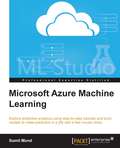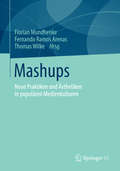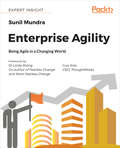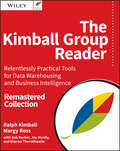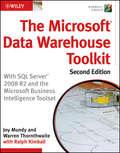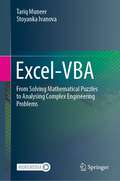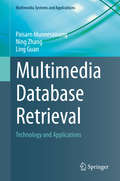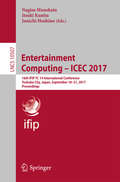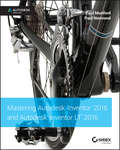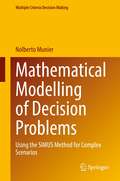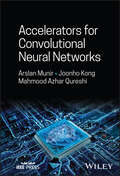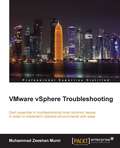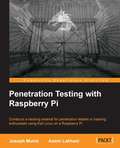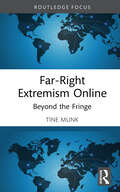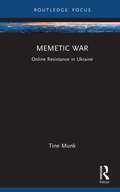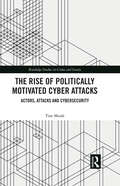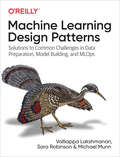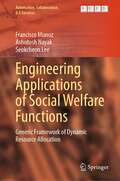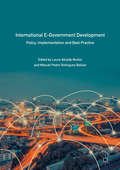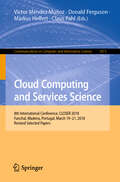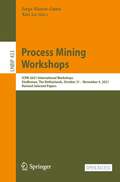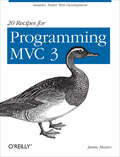- Table View
- List View
CLEAN: CO2 Large-Scale Enhanced Gas Recovery in the Altmark Natural Gas Field - GEOTECHNOLOGIEN Science Report No. 19 (Advanced Technologies in Earth Sciences)
by Ute Münch Michael KühnThe project CLEAN (CO2 Large-Scale Enhanced Gas Recovery in the Altmark Natural Gas Field) provides site specific knowledge for a potential future pilot project. This contributed volume gives an overview and final results of the entire project which is finalized to the end of 2012.
Microsoft Azure Machine Learning
by Sumit MundThe book is intended for those who want to learn how to use Azure Machine Learning. Perhaps you already know a bit about Machine Learning, but have never used ML Studio in Azure; or perhaps you are an absolute newbie. In either case, this book will get you up-and-running quickly.
Mashups
by Florian Mundhenke Fernando Ramos Arenas Thomas WilkeMashup hat sich als Begriff eingebürgert für auditiv, visuell, audiovisuell ,,vermischte" Neuarrangements, Collagen, Bricolagen in der Musik, in Videos, in Computerspielen, in der (aktuellen Medien-)Kunst, in der Architektur. Es handelt sich um eine Verbindung heterogener Elemente, die etwas (scheinbar) Neues hervorbringen. Im Internet verbinden Websites unterschiedliche Elemente (beispielsweise Musik, Video, Hyperlinks) mit unterschiedlichen Funktionen. Ausgangspunkt für diesen Band ist die These, dass es einerseits mediale und kulturelle Techniken gibt, die diese Form des Mischgenres erst ermöglichen. Andererseits muss berücksichtigt werden, dass die mediale Kompetenz der User exponentiell angestiegen ist und weiter ansteigt. Der Band geht unter anderem der Frage nach, inwieweit es sich bei Mashups um eine qualitativ neue Form der Aneignung und/oder nur eine produktive Auseinandersetzung mit medialen Angeboten handelt.
Enterprise Agility: Being Agile in a Changing World
by Sunil MundraEnterprise Agility is practical framework for enhancing Agility and equipping your company with the tools to survive. Key Features● Prepare your company to navigate the rapidly-moving business world● Enhance Agility in every component of your organization● Build a framework that meets the unique requirements of your enterpriseBook DescriptionThe biggest challenge enterprises face today is dealing with fast-paced change in all spheres of business. Enterprise Agility shows how an enterprise can address this challenge head on and thrive in the dynamic environment. Avoiding the mechanistic construction of existing enterprises that focus on predictability and certainty, Enterprise Agility delivers practical advice for responding and adapting to the scale and accelerating pace of disruptive change in the business environment.Agility is a fundamental shift in thinking about how enterprises work to effectively deal with disruptive changes in the business environment. The core belief underlying agility is that enterprises are open and living systems. These living systems, also known as complex adaptive systems (CAS), are ideally suited to deal with change very effectively.Agility is to enterprises what health is to humans. There are some foundational principles that can be broadly applied, but the definition of healthy is very specific to each individual. Enterprise Agility takes a similar approach with regard to agility: it suggests foundational practices to improve the overall health of the body—culture, mindset, and leadership—and the health of its various organs: people, process, governance, structure, technology, and customers. The book also suggests a practical framework to create a plan to enhance agility.What you will learnDrive agility-oriented change across the enterpriseUnderstand why agility matters (more than ever) to modern enterprises Adopt and influence an Agile mindset in your teams and in your organization Understand the concept of a CAS and how to model enterprise and leadership behaviors on CAS characteristics to enhance enterprise agility Understand and convey the differences between Agile and true enterprise agility Create an enterprise-specific action plan to enhance agility Become a champion for enterprise agilityRecognize the advantages and challenges of distributed teams, and how Agile ways of working can remedy the rough spotsEnable and motivate your IT partners to adopt Agile ways of workingWho this book is forEnterprise Agility is a tool for anyone with the motivation to influence outcomes in an enterprise, who aspires to improve Agility. Readers from the following backgrounds will benefit: chief executive officer, chief information officer, people/human resource director, information technology director, head of change program, head of transformation, and Agile coach/consultant.
The Kimball Group Reader
by Joy Mundy Bob Becker Margy Ross Ralph Kimball Warren ThornthwaiteAn unparalleled collection of recommended guidelines for data warehousing and business intelligence pioneered by Ralph Kimball and his team of colleagues from the Kimball Group.Recognized and respected throughout the world as the most influential leaders in the data warehousing industry, Ralph Kimball and the Kimball Group have written articles covering more than 250 topics that define the field of data warehousing. For the first time, the Kimball Group's incomparable advice, design tips, and best practices have been gathered in this remarkable collection of articles, which spans a decade of data warehousing innovation.Each group of articles is introduced with original commentaries that explain their role in the overall lifecycle methodology developed by the Kimball Group. These practical, hands-on articles are fully updated to reflect current practices and terminology and cover the complete lifecycle--including project planning, requirements gathering, dimensional modeling, ETL, and business intelligence and analytics.This easily referenced collection is nothing less than vital if you are involved with data warehousing or business intelligence in any capacity.
The Microsoft Data Warehouse Toolkit
by Joy Mundy Warren Thornthwaite Ralph KimballBest practices and invaluable advice from world-renowned data warehouse experts In this book, leading data warehouse experts from the Kimball Group share best practices for using the upcoming "Business Intelligence release" of SQL Server, referred to as SQL Server 2008 R2. In this new edition, the authors explain how SQL Server 2008 R2 provides a collection of powerful new tools that extend the power of its BI toolset to Excel and SharePoint users and they show how to use SQL Server to build a successful data warehouse that supports the business intelligence requirements that are common to most organizations. Covering the complete suite of data warehousing and BI tools that are part of SQL Server 2008 R2, as well as Microsoft Office, the authors walk you through a full project lifecycle, including design, development, deployment and maintenance. Features more than 50 percent new and revised material that covers the rich new feature set of the SQL Server 2008 R2 release, as well as the Office 2010 release Includes brand new content that focuses on PowerPivot for Excel and SharePoint, Master Data Services, and discusses updated capabilities of SQL Server Analysis, Integration, and Reporting Services Shares detailed case examples that clearly illustrate how to best apply the techniques described in the book The accompanying Web site contains all code samples as well as the sample database used throughout the case studies The Microsoft Data Warehouse Toolkit, Second Edition provides you with the knowledge of how and when to use BI tools such as Analysis Services and Integration Services to accomplish your most essential data warehousing tasks.
Excel-VBA: From Solving Mathematical Puzzles to Analysing Complex Engineering Problems (Springerbriefs In Applied Sciences And Technology Ser.)
by Tariq Muneer Stoyanka IvanovaThis compact text is a powerful introduction to the Excel/VBA computing environment. The book presents some of the most useful features of Excel. First by introducing mathematical puzzles that will grab the reader’s attention with the reader invited to think hard on solving those puzzles. Then, solutions are presented in a logical manner. The book goes on to describe modern and up-to-date engineering problems and their solutions. Based on many years of the authors’ teaching, the book provides a practical, useful and enjoyable learning methods for readers to become expert in Excel and its application to engineering.
Multimedia Database Retrieval
by Paisarn Muneesawang Ning Zhang Ling GuanThis book explores multimedia applications that emerged from computer vision and machine learning technologies. These state-of-the-art applications include MPEG-7, interactive multimedia retrieval, multimodal fusion, annotation, and database re-ranking. The application-oriented approach maximizes reader understanding of this complex field. Established researchers explain the latest developments in multimedia database technology and offer a glimpse of future technologies. The authors emphasize the crucial role of innovation, inspiring users to develop new applications in multimedia technologies such as mobile media, large scale image and video databases, news video and film, forensic image databases and gesture databases. With a strong focus on industrial applications along with an overview of research topics, Multimedia Database Retrieval: Technology and Applications is an indispensable guide for computer scientists, engineers and practitioners involved in the development and use of multimedia systems. It also serves as a secondary text or reference for advanced-level students interested in multimedia technologies.
Entertainment Computing – ICEC 2017: 16th Ifip Tc 14 International Conference, Tsukuba City, Japan, September 18-21, 2017, Proceedings (Lecture Notes in Computer Science #10507)
by Nagisa Munekata Itsuki Kunita Junichi HoshinoThis book constitutes the refereed proceedings of the 16th International Conference on Entertainment Computing, ICEC 2017, held in Tsukuba City, Japan, in September 2017. The 16 full papers, 13 short papers, and 2 posters presented were carefully reviewed and selected from 46 submissions.
Mastering Autodesk Inventor 2016 and Autodesk Inventor LT 2016: Autodesk Official Press
by Paul Munford Paul NormandYour real-world introduction to mechanical design with Autodesk Inventor 2016 Mastering Autodesk Inventor 2016 and Autodesk Inventor LT 2016 is a complete real-world reference and tutorial for those learning this mechanical design software. With straightforward explanations and practical tutorials, this guide brings you up to speed with Inventor in the context of real-world workflows and environments. You'll begin designing right away as you become acquainted with the interface and conventions, and then move into more complex projects as you learn sketching, modeling, assemblies, weldment design, functional design, documentation, visualization, simulation and analysis, and much more. Detailed discussions are reinforced with step-by-step tutorials, and the companion website provides downloadable project files that allow you to compare your work to the pros. Whether you're teaching yourself, teaching a class, or preparing for the Inventor certification exam, this is the guide you need to quickly gain confidence and real-world ability. Inventor's 2D and 3D design features integrate with process automation tools to help manufacturers create, manage, and share data. This detailed guide shows you the ins and outs of all aspects of the program, so you can jump right in and start designing with confidence. Sketch, model, and edit parts, then use them to build assemblies Create exploded views, flat sheet metal patterns, and more Boost productivity with data exchange and visualization tools Perform simulations and stress analysis before the prototyping stage This complete reference includes topics not covered elsewhere, including large assemblies, integrating other CAD data, effective modeling by industry, effective data sharing, and more. For a comprehensive, real-world guide to Inventor from a professional perspective, Mastering Autodesk Inventor 2016 and Autodesk Inventor LT 2016 is the easy-to-follow hands-on training you've been looking for.
Regulation Fixtures in Hydronic Heating Installations: Types, Structures, Characteristics and Applications (Studies in Systems, Decision and Control #187)
by Damian Piotr MuniakThe book focuses on design and computational issues related to fixtures and armatures in hydronic heating installations, especially regulation valves, their selection, operating principles, types and construction. The analysis is complemented by connection diagrams, drawings, photos of the valves and computational examples of their selection and operation parameters when used in a pipework and a controlled object, like a radiator. It also discusses issues related to the so-called valve authority, one of the main parameters determining the quality of the valve regulation process. Further, it includes an extensive theoretical framework along with a detailed mathematical analysis and proposes new algorithms, which have been verified and confirmed experimentally. Based on this analysis, the book presents the author’s analytical approach for sizing a regulation valve, as well as an innovative design solution for a regulation valve without the limitations of the valves currently available on the market. Lastly, it introduces a new verified method of calculating the valve pre-setting. Intended for engineers dealing with heating issues, scientists and students studying environmental engineering, energetics and related fields, the book is also useful for lecturers, designers, and those operating heating installations, as well as authors of computer programs for thermal and hydraulic balancing of heating installations.
Mathematical Modelling of Decision Problems: Using the SIMUS Method for Complex Scenarios (Multiple Criteria Decision Making)
by Nolberto MunierThis book is intended as a guide to and manual on modeling complex problems in Multi Criteria Decision Making (MCDM). It encourages practitioners to consider the practicalities of real-world scenarios when modeling, while at the same time providing tips and examples of how to incorporate these realities into the initial decision matrix. The goal is to help readers build a decision matrix that replicates reality as closely as possible. Once this matrix has been constructed, the Decision Maker (DM) can select from more than a hundred MCDM methods the one that best fits the requirements and conditions of the matrix. The book features cases taken from real-world scenarios, which deal with various fields, aspects, and characteristics, and are solved using the SIMUS (Sequential Interactive Modeling for Urban Systems) method. This book is a valuable tool for practitioners, researchers and students dealing with MCDM problems.
Accelerators for Convolutional Neural Networks
by Arslan Munir Joonho Kong Mahmood Azhar QureshiAccelerators for Convolutional Neural Networks Comprehensive and thorough resource exploring different types of convolutional neural networks and complementary accelerators Accelerators for Convolutional Neural Networks provides basic deep learning knowledge and instructive content to build up convolutional neural network (CNN) accelerators for the Internet of things (IoT) and edge computing practitioners, elucidating compressive coding for CNNs, presenting a two-step lossless input feature maps compression method, discussing arithmetic coding -based lossless weights compression method and the design of an associated decoding method, describing contemporary sparse CNNs that consider sparsity in both weights and activation maps, and discussing hardware/software co-design and co-scheduling techniques that can lead to better optimization and utilization of the available hardware resources for CNN acceleration. The first part of the book provides an overview of CNNs along with the composition and parameters of different contemporary CNN models. Later chapters focus on compressive coding for CNNs and the design of dense CNN accelerators. The book also provides directions for future research and development for CNN accelerators. Other sample topics covered in Accelerators for Convolutional Neural Networks include: How to apply arithmetic coding and decoding with range scaling for lossless weight compression for 5-bit CNN weights to deploy CNNs in extremely resource-constrained systems State-of-the-art research surrounding dense CNN accelerators, which are mostly based on systolic arrays or parallel multiply-accumulate (MAC) arrays iMAC dense CNN accelerator, which combines image-to-column (im2col) and general matrix multiplication (GEMM) hardware acceleration Multi-threaded, low-cost, log-based processing element (PE) core, instances of which are stacked in a spatial grid to engender NeuroMAX dense accelerator Sparse-PE, a multi-threaded and flexible CNN PE core that exploits sparsity in both weights and activation maps, instances of which can be stacked in a spatial grid for engendering sparse CNN accelerators For researchers in AI, computer vision, computer architecture, and embedded systems, along with graduate and senior undergraduate students in related programs of study, Accelerators for Convolutional Neural Networks is an essential resource to understanding the many facets of the subject and relevant applications.
VMware vSphere Troubleshooting
by Muhammad Zeeshan MunirGain expertise in troubleshooting most common issues to implement vSphere environments with easeAbout This BookPlan, analyze, and design effective solutions for your vSphere environmentTroubleshoot problems related to vSphere performanceFamiliarize yourself with the advanced troubleshooting conceptsand become an xpert level administratorWho This Book Is ForThe books is intended for mid-level System Engineers and System Integrators who want to learn VMware power tools to troubleshoot and manage the vSphere infrastructure. Good knowledge level and understanding of virtualization is expected.What You Will LearnConfigure vSphere management assistant and troubleshooting toolsUse troubleshooting tools to monitor performance and troubleshoot different issuesLearn how to troubleshoot High Availability and other commonly known problems with clusters such as insufficient resources, failing heartbeatsUse Direct Console User Interface (DCUI) to verify configurationDiagnose storage issues including iSCSI, NFS and VMFS problemsManage vSphere Network Virtual and Distributed Switches, Trunks, VLANSMonitor and shape network traffic, configure routes and DNSQuickly resolve common day-to-day problems by analysing logs of VMware vSphere hosts and VMware vCenter ServerDebug and resolve commonly known vSphere Cluster problemsIn DetailVMware vSphere is the leading server virtualization platform with consistent management for virtual data centers. It enhances troubleshooting skills to diagnose and resolve day to day problems in your VMware vSphere infrastructure environment.This book will provide you practical hands-on knowledge of using different performance monitoring and troubleshooting tools to manage and troubleshoot the vSphere infrastructure.It begins by introducing systematic approach for troubleshooting different problems and show casing the troubleshooting techniques. You will be able to use the troubleshooting tools to monitor performance, and troubleshoot issues related to Hosts and Virtual Machines. Moving on, you will troubleshoot High Availability, storage I/O control problems, virtual LANS, and iSCSI, NFS, VMFS issues.By the end of this book, you will be able to analyze and solve advanced issues related to vShpere environment such as vcenter certificates, database problems, and different failed state errors.Style and approachA step-by-step guide full of real world scenarios that will enhance advanced knowledge, skills, and abilities to achieve competence in troubleshooting the VMware vSphere environment. Basic concepts of vSphere and the most common vSphere infrastructure problems are explained with practical solutions to resolve it.
Penetration Testing with Raspberry Pi
by Joseph Muniz Aamir LakhaniIf you are looking for a low budget, small form-factor remotely accessible hacking tool, then the concepts in this book are ideal for you. If you are a penetration tester who wants to save on travel costs by placing a low-cost node on a target network, you will save thousands by using the methods covered in this book. You do not have to be a skilled hacker or programmer to use this book. It will be beneficial to have some networking experience; however, it is not required to follow the concepts covered in this book.
Fools Rush In: Steve Case, Jerry Levin, and the Unmaking of AOL Time Warner
by Nina MunkA carefully explained business debacle.
Far-Right Extremism Online: Beyond the Fringe (Routledge Studies in Digital Extremism)
by Tine MunkBy imparting crucial insights into the digital evolution of far-right extremism and its challenges, this book explores how far-right extremism has transformed, utilising digital spaces for communication and employing coded language to evade detection.Far-right extremism has spread extensively across online platforms. Flourishing within echo chambers, these groups propagate different types of online and offline actions and advance their hateful ideologies to a wide-ranging audience. This book highlights the issues surrounding far-right extremism, which distinguishing it from terrorism and examining its contemporary digital manifestations. Importantly, it sheds light on how far-right groups utilise online platforms for communication, radicalisation, and on-ground actions, relying on alternative truths, misinformation, conspiracy theories, fashion, and memes to connect with like-minded individuals. The book also addresses content moderation challenges and the impact of rising populism in today’s political climate, which fuels societal divisions and uncertainty.Far-Right Extremism Online is a valuable resource for academics, students, analysts, and professionals working in counter-extremism, cybersecurity, digital communication, and national security. It is also an indispensable guide for those concerned about far-right extremism in the digital age.
Memetic War: Online Resistance in Ukraine (Routledge Studies in Crime and Society)
by Tine MunkMemetic War analyses memetic warfare included in cyber war and aims to develop a framework for understanding the parameters included in utilising this concept in Ukraine as a part of civic resistance.In the Ukrainian war, an informal defence tactic has developed to uphold the information flow about the war and to debunk Russia’s communications. The war has enhanced the visibility of governmental and civic activation by using the advantages of social media architecture, networks, and communication forms. The book investigates Ukraine’s public and private abilities to develop cyber capabilities to counter propaganda and dis-and-misinformation online as a defence mechanism. This book uses military ROC doctrine to understand government authorities, the armed forces, and civic engagement in the Ukrainian resistance.Memetic War will have relevance for scholars, researchers, and academics in the cybersecurity field, practitioners, governmental actors, and military and strategic personnel.
The Rise of Politically Motivated Cyber Attacks: Actors, Attacks and Cybersecurity (Routledge Studies in Crime and Society)
by Tine MunkThis book outlines the complexity in understanding different forms of cyber attacks, the actors involved, and their motivations. It explores the key challenges in investigating and prosecuting politically motivated cyber attacks, the lack of consistency within regulatory frameworks, and the grey zone that this creates, for cybercriminals to operate within. Connecting diverse literatures on cyberwarfare, cyberterrorism, and cyberprotests, and categorising the different actors involved – state-sponsored/supported groups, hacktivists, online protestors – this book compares the means and methods used in attacks, the various attackers, and the current strategies employed by cybersecurity agencies. It examines the current legislative framework and proposes ways in which it could be reconstructed, moving beyond the traditional and fragmented definitions used to manage offline violence. This book is an important contribution to the study of cyber attacks within the areas of criminology, criminal justice, law, and policy. It is a compelling reading for all those engaged in cybercrime, cybersecurity, and digital forensics.
Machine Learning Design Patterns
by Michael Munn Valliappa Lakshmanan Sara RobinsonThe design patterns in this book capture best practices and solutions to recurring problems in machine learning. The authors, three Google engineers, catalog proven methods to help data scientists tackle common problems throughout the ML process. These design patterns codify the experience of hundreds of experts into straightforward, approachable advice.In this book, you will find detailed explanations of 30 patterns for data and problem representation, operationalization, repeatability, reproducibility, flexibility, explainability, and fairness. Each pattern includes a description of the problem, a variety of potential solutions, and recommendations for choosing the best technique for your situation.You'll learn how to:Identify and mitigate common challenges when training, evaluating, and deploying ML modelsRepresent data for different ML model types, including embeddings, feature crosses, and moreChoose the right model type for specific problemsBuild a robust training loop that uses checkpoints, distribution strategy, and hyperparameter tuningDeploy scalable ML systems that you can retrain and update to reflect new dataInterpret model predictions for stakeholders and ensure models are treating users fairly
Engineering Applications of Social Welfare Functions: Generic Framework of Dynamic Resource Allocation (Automation, Collaboration, & E-Services #13)
by Francisco Munoz Ashutosh Nayak Seokcheon LeeThis book presents social welfare functions as a unified multidisciplinary framework for various resource allocation problems. By measuring the impact of local decisions on broader society, social welfare functions enable “socialized” decisions and thereby produce an emergent property that “global” balance and welfare emerge from “local” welfare-maximizing behaviors. Social welfare functions are originally used in economics to quantify income welfare, jointly considering average and inequality to arrive at better measures of welfare than average alone. Wishing the readers to find opportunities for their problems of interest, this book introduces research results of social welfare functions applied in five different engineering applications, defining welfare metrics pertaining to the characteristics of the application. The “energy welfare” in wireless sensor network measures richness of distributed sensors in energy. The “preparedness welfare” in emergency medical services quantifies the preparedness level of an entire service area by aggregating preparedness levels of individual zones. The “preference welfare” in intelligent shared environments represents the opinions of real people for groups. The “resource welfare” in multi-robot task allocation quantifies the efficiency of utilizing distributed resources across robots. The “utility welfare” in complex cyber-physical systems quantifies the impact of local resource sharing decisions on the broader task communities.
International E-Government Development
by Laura Alcaide Muñoz Manuel Pedro Rodríguez BolívarThis book provides an examination of e-Government frameworks and maturity stages in governments around the world, including an overview of the legal frameworks that have supported them. Divided into three sections, the first part of this book analyses the theoretical context of current policies, codes of best practice and their implementation. The second section presents case studies which bring key issues to the fore including open government, privacy protection, social media, democracy, systems failures, innovations in inter-organizational e-government projects, and open data systems. The authors demonstrate the importance of the successful implementation of e-Government for improving managerial efficiency, public service delivery and citizen engagement, with special attention given to developing countries. The book concludes by drawing out the lessons learned from the latest research and recommending solutions for improving the implementation of e-Government in the future, thereby helping to achieve more transparent, participative and democratic societies. This book will provide an invaluable resource for researchers, policy-makers, public managers, international organizations and technical experts.
Cloud Computing and Services Science: 8th International Conference, CLOSER 2018, Funchal, Madeira, Portugal, March 19-21, 2018, Revised Selected Papers (Communications in Computer and Information Science #1073)
by Víctor Méndez Muñoz Donald Ferguson Markus Helfert Claus PahlThis book constitutes extended, revised and selected papers from the 8th International Conference on Cloud Computing and Services Science, CLOSER 2018, held in Funchal, Portugal in March 2018. The 11 papers presented in this volume were carefully reviewed and selected from a total of 94 submissions. CLOSER 2018 focused on the emerging area of Cloud Computing, inspired by some latest advances that concern the infrastructure, operations and available services throughout the global network.
Process Mining Workshops: ICPM 2021 International Workshops, Eindhoven, The Netherlands, October 31 – November 4, 2021, Revised Selected Papers (Lecture Notes in Business Information Processing #433)
by Jorge Munoz-Gama Xixi LuThis open access book constitutes revised selected papers from the International Workshops held at the Third International Conference on Process Mining, ICPM 2021, which took place in Eindhoven, The Netherlands, during October 31–November 4, 2021. The conference focuses on the area of process mining research and practice, including theory, algorithmic challenges, and applications. The co-located workshops provided a forum for novel research ideas. The 28 papers included in this volume were carefully reviewed and selected from 65 submissions. They stem from the following workshops: 2nd International Workshop on Event Data and Behavioral Analytics (EDBA) 2nd International Workshop on Leveraging Machine Learning in Process Mining (ML4PM) 2nd International Workshop on Streaming Analytics for Process Mining (SA4PM) 6th International Workshop on Process Querying, Manipulation, and Intelligence (PQMI) 4th International Workshop on Process-Oriented Data Science for Healthcare (PODS4H) 2nd International Workshop on Trust, Privacy, and Security in Process Analytics (TPSA)One survey paper on the results of the XES 2.0 Workshop is included.
20 Recipes for Programming MVC 3: Faster, Smarter Web Development
by Jamie MunroThere's no need to reinvent the wheel every time you run into a problem with ASP.NET's Model-View-Controller (MVC) framework. This concise cookbook provides recipes to help you solve tasks many web developers encounter every day. Each recipe includes the C# code you need, along with a complete working example of how to implement the solution. Learn practical techniques for applying user authentication, providing faster page reloads, validating user data, filtering search results, and many other issues related to MVC3 development. These recipes help you: Restrict access to views with password protection Allow users to upload and save a file to your website Implement AJAX to allow users to see updated content quickly Validate form input to ensure the data you capture is what you expect Create thumbnails to preview images rather than view them full-size Give your web application the ability to change languages Use CAPTCHA to prevent automated programs from completing forms Make URLs more user- and search-engine-friendly with the MapRoute function

